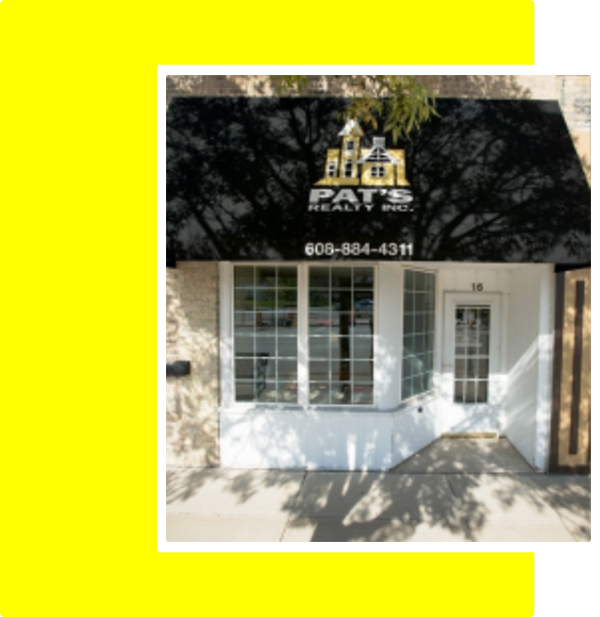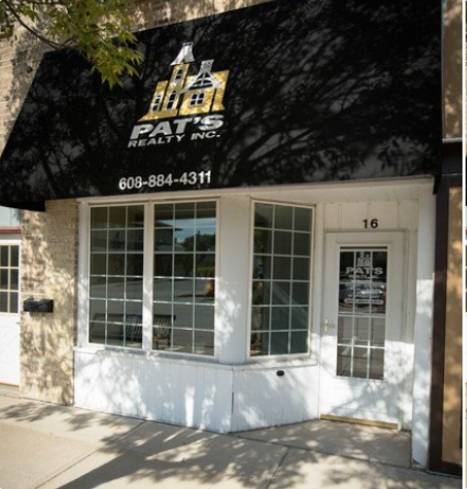Buyers
Step-by-Step Guide to Buying A Home
Buying a home or any property can seem daunting at times, but we are here to help you through every step of the way. Here we provide a step-by-step guide on how the process works. If you have any questions, just call us.
How we help you buy a home
Buying a home is probably the biggest financial commitment you’ll ever make. At Pat’s Realty, Inc., our goal is to provide you with a full service, anxiety-free real estate experience. We will deliver a level of service unmatched in the real estate industry. At Pat’s Realty, Inc., our realtors listen to you, and understand your needs, so they can show you more suitable properties, offer valuable advice, and guide you through the entire home buying process. Let us show you how easy your real estate purchase can be. Here is a breakdown of our services to help you buy a home.
Mortgage Calculator
If you are thinking about buying a property, and don’t have a ton of cash on hand, you will probably need to get a mortgage. Getting a quick idea of what you can afford is an important first step in your planning process. Here is a simple online tool that can help you get an idea of what you can afford. After you move along in the process a bit, meeting with a mortgage lender will be the best way to know how much you can borrow. Give us a call if you need advice on finding a quality local lender.


First-time Homebuyer’s Guide



Southern WI Communities
Interested in learning more about the great communities we have in Southern WI? Looking for a new place to explore? Here we provide a little background on a few communities around and some helpful links for you to learn more


Local Service Providers
We know that buying and selling a property can sometimes seem daunting, but we are here to help guide you through the process. Over the years we have learned many things and want to share our insights with you. Here are a few resources we hope will help you navigate the real estate process.



Pat’s Perspectives
Additional Resources
Step-by-Step Guide to Buying A Home
“How To Buy A House In 13 Steps”
Step 1: Decide Whether You’re Ready To Buy A Home
Buying a house is a major commitment. Before you begin shopping for properties or comparing mortgage options, you need to make sure you’re ready to be a homeowner. Wondering if you should buy a house? Let’s look at some of the factors that lenders and homeowners alike should consider.
Income And Employment Status
Your lender won’t just want to see how much money you make. They’ll also want to see a work history (usually about 2 years) to make sure your income source is stable and reliable.
Preparing your income is all about pulling the right documentation together to show steady employment. If you’re on payroll, you’ll likely just need to provide recent pay stubs and W-2s. On the other hand, you’ll need to submit your tax returns and other documents the lender requests if you’re self-employed.
Debt-To-Income Ratio
Debt-to-income ratio (DTI) is another financial instrument mortgage lenders use to evaluate your loan application. Your DTI helps your lender see how much of your monthly income goes to debt so they can evaluate the amount of mortgage debt you can take on.
DTI is calculated by dividing your monthly debt by your gross monthly income. For example, if your monthly debts (credit card minimum payments, loan payments, etc.) total $2,000 per month and your gross monthly income is $6,000, your DTI is $2,000/$6,000, or 33%. Your lender will use the debts shown on your credit report to calculate your DTI.
Depending on the type of loan you’re applying for, your lender may also calculate your housing expense ratio, also sometimes referred to as front-end DTI. This is a ratio that looks at your total monthly house payment (principal, interest, taxes and insurance) compared to your monthly income. For example, if you have a $1,200 house payment and the same $6,000 monthly income, your housing expense ratio is $1,200/$6,000, or 20%.
It’s smart to review your DTI before you apply for a loan. In most cases, you’ll need a back-end DTI of 43% or less to qualify for the most mortgage options, although this number varies based on your lender, loan type and other factors.
Liquid Assets
Even with the help of a mortgage, you’ll still need liquid assets to fund the purchase of a home, specifically your:
Down payment: Buying a home with no money down is possible, but most homeowners need to have some cash for a down payment. A down payment is the first major payment you make on your loan at closing.
The amount of money you’ll need for a down payment depends on your loan type and how much money you borrow. You can buy a home with as little as 3% down (though there are benefits to putting down more).
Closing costs: You’ll also need to pay for closing costs before you move into your new home. Closing costs are fees that go to your lender and other third parties in exchange for creating your loan.
The specific amount you’ll pay in closing costs will depend on where you live and your loan type. It’s a good idea to be prepared for 3 – 6% of your home’s value as an estimate of your closing costs. In some situations, part of closing costs can be rolled into your mortgage or paid by the seller using seller concessions.
Credit Health
Your credit score plays a huge role in what loans and interest rates you qualify for. Your credit score tells lenders how much of a risk you are to grant a loan.
Taking steps to improve your credit score and reduce your debt can pay off big as you prepare to get a mortgage. Better numbers mean better loan options with lower interest rates.
Your credit score is based on the following information:
-
- Your payment history
- The amount of money you owe
- The length of your credit history
- Types of credit you’ve used
- Your pursuit of new credit
What score will you need to qualify for a home loan? Most lenders require a credit score of at least 620 to qualify for the majority of loans. A score above 720 will generally get you the very best loan terms.
At Rocket Mortgage®, you can qualify for an FHA or VA loan with a 580 median FICO® Score. However, to qualify for these with a median score below 620, you’ll need a housing expense ratio of no more than 38% and an overall DTI no higher than 45%.
Willingness To Live In One Place
A mortgage can be a 30-year-long commitment. Though you don’t need to live in your home for the entirety of your mortgage term, it’s still a big decision. When you own a home, it’s more difficult to move. Unless you’re buying a second home or investment property, you might need to sell your current home first, which can take time.
Decide whether you’re ready to live in your current area for at least a few more years. Consider your career goals, family obligations and more. Each of these factors will play a major role in the type of home you buy and where you set up your primary residence.
Timing
Deciding whether it’s a good time to buy a house or not depends on a variety of personal factors (such as financial readiness and lifestyle preferences) and market conditions (such as economic health and current mortgage rates).
Ultimately, the right time to buy a home comes down to your own unique situation. Be sure to consult a financial expert before making any big financial decisions such as buying a house.
Step 2: Calculate How Much You Can Afford On A House
Step 3: Save For A Down Payment And Closing Costs
Down Payment
Your down payment is a large, one-time payment toward the purchase of a home. Many lenders require a down payment, because it mitigates the loss they might suffer in the event that a borrower defaults on their mortgage. Many home buyers believe that they need a 20% down payment to buy a home. This isn’t true. Plus, a down payment of that size isn’t realistic for many first-time home buyers. Fortunately, there are many options for buyers who can’t afford a 20% down payment. For example, you can get a conventional loan for as little as 3% down. Federal Housing Administration (FHA) loans have a minimum down payment of 3.5%. Department of Veterans Affairs (VA) loans and United States Department of Agriculture (USDA) loans even allow eligible and qualified borrowers to put 0% down. There are advantages, however, to making a larger down payment. For one, it typically means you’ll have more mortgage options. It also usually means you’ll have a smaller monthly payment and a lower interest rate. Plus, if you put at least 20% down on a conventional loan, you won’t need to pay for private mortgage insurance (PMI). Closing Costs You’ll also need to save money to cover closing costs – the fees you pay to get the loan. There are many variables that go into determining how much you’ll pay for closing costs, but it’s usually smart to prepare for 3 – 6% of the home value. This means that if you’re buying a home worth $200,000, you might pay $6,000 – $12,000 in closing costs. The specific closing costs will depend on your loan type, your lender and where you live. Almost all homeowners will pay for things like appraisal fees and title insurance. If you take out a government-backed loan, you’ll typically need to pay an insurance premium or funding fee upfront. Before you close on your loan, your lender will give you a document called a Closing Disclosure, which lists each of the closing costs you need to cover and how much you’ll need to pay at closing. Look over your Closing Disclosure carefully before you close to know what to expect and to catch any errors.Other Costs Based On Loan Type
Your loan type might require a specialized inspection as well. For example, you often have to get a pest inspection before you take out a VA loan. Most lenders will schedule this inspection on your behalf and pass the cost along to you at closing. These expenses might seem minor when held up against the other costs associated with buying a home, but they can add up, so be sure to budget wisely.Step 4: Decide What Type Of Mortgage Is Right For You
Conventional Loans
Conventional loans are mortgages made by a private lender and not backed by the government. The most common type of conventional loan are loans that are backed by Fannie Mae or Freddie Mac, sometimes called conforming loans. The majority of mortgages in the U.S. are conventional loans. Conventional loans are always a popular option for home buyers, and you can get one with as little as 3% down.FHA Loans
Backed by the Federal Housing Administration, FHA loans are less of a risk for lenders because the government insures them if you stop making payments. As a result, FHA loans have credit score requirements that aren’t as strict. You can get an FHA loan with a down payment as small as 3.5%.VA Loans
VA loans are mortgage loans for veterans, active-duty members of the Armed Forces, eligible reservists or National Guard members and qualifying surviving spouses. The most popular benefit of VA loans for home buyers is no down payment required. VA loans are insured by the Department of Veterans Affairs.USDA Loans
Another type of government-backed loan, a USDA loan, helps people in rural and suburban areas buy homes. You can get a USDA loan with 0% down, but your home must be in an acceptable rural area and you must meet income eligibility rules.Rocket Mortgage doesn’t offer USDA loans at this time.Step 5: Get Preapproved For A Mortgage
Step 6: Find The Right Real Estate Agent For You
Step 7: Begin House Hunting
-
- Here are some things you might want to consider when shopping for a house:
- Price
- Square footage
- Home condition and possible need for repairs
- Access to public transportation
- Number of bedrooms
- Backyard/swimming pool
- Local entertainment options
- Local school district ranking
- Property value trends
- Property/real estate taxes
Step 8: Make An Offer On A House
-
- Accept the offer: If the seller accepts the offer, you can move onto the next step.
- Reject the offer: If the seller rejects your offer, the ball is back in your court. You can choose to submit another offer or move on to another home.
- Give you a counteroffer: The seller can also come back with a counteroffer of their own. They may change the purchase price or the terms of the sale. You can accept the counteroffer, reject it, or make another counteroffer.
Step 9: Get A Home Inspection
Step 10: Get A Home Appraisal
Step 11: Ask For Repairs Or Credits
-
- Ask for a discounted purchase price considering the results.
- Request that the seller give you credits to cover some of your closing costs.
- Ask that the seller have the problems fixed before you close.
Step 12: Do A Final Walkthrough
Step 13: Close On Your New Home
How we help you buy a home
Buying a home is probably the biggest financial commitment you’ll ever make. At Pat’s Realty, Inc., our goal is to provide you with a full service, anxiety-free real estate experience. We will deliver a level of service unmatched in the real estate industry. At Pat’s Realty, Inc., our realtors listen to you, and understand your needs, so they can show you more suitable properties, offer valuable advice, and guide you through the entire home buying process. Let us show you how easy your real estate purchase can be.
FREE representation – Typically buyer’s agents are paid a commission from the company that lists the property – which means we work for you and the sellers of the home you buy pay us… so it’s in your best interest to have your own agent represent you in the home buying process.
Loyalty – We represent you, which means we are looking out for YOUR best interests, not ours, not the seller’s, not anyone’s but yours.
Guidance/Transaction Management – We know South Central WI well, and can guide in to find the community and neighborhood that is right for you. We also work with you on all contingencies that you might want to have such as an inspection, water and well tests, radon inspections and more. We’re always 3 steps ahead and work hard to make the whole process as smooth and beneficial to you as possible.
Knowledge of the market – We have a thorough knowledge of the region and often know the background on the property you might be interested in. We are able to guide you to make sure your offer is strong, but fair and not over market value.
Concierge Service – Whether you need an inspector, contractor, lender/banker, financial advisor, closing attorney, etc, we work with the best in the business and can connect you with reputable professionals to get you where you need to be.
Excellent Negotiating on your behalf – Good negotiating comes in many forms. Our understanding of the market, reputation in the industry, the way we run numbers, and full understanding of ALL of the nuances of an Offer to Purchase can both protect you and also get you the home you want when running into a multiple offer situation.
First-time Buyers Guide
Everything you need to know to make that big purchase easier
By AMY FONTINELLE
Updated October 12, 2021
Reviewed by ANDY SMITH
Fact checked by KATHARINE BEER
Buying a home can be challenging for a first-timer. After all, there are so many steps, tasks, and requirements, and you may be anxious about making an expensive mistake. But first-time homebuyers actually enjoy some special advantages created to encourage new entrants into the real estate market.
KEY TAKEAWAYS
- First-time homebuyers, as defined by the U.S. Department of Housing and Urban Development (HUD), can get help from state programs, tax breaks, and federally backed loans.
- Before you begin looking, consider the type of residence that will serve your needs, what you can afford, how much financing you can secure, and who will help you conduct your search.
- Buying a home involves finding the property, securing financing, making an offer, getting a home inspection, and closing on the purchase.
- Once you’ve moved in, it’s important to maintain your home and keep saving.
- To demystify the process so you get the most out of your purchase, here is a rundown of what you need to consider before you buy and what you can expect from the buying process itself, plus tips to make life easier after you buy your first home.
The First-Time Homebuyer Advantage
Buying a home is still considered a key aspect of the American dream. As a first-time buyer, you have access to state programs, tax breaks, and federally backed loans if you don’t have the usual minimum down payment—ideally, 20% of the purchase price for a conventional loan—or are a member of a certain group (see the Important callout below). And you may qualify as a first-time buyer even if you’re not a novice.
A first-time homebuyer, according to the U.S. Department of Housing and Urban Development (HUD), is someone who meets any of the following conditions:
- An individual who has not owned a principal residence for three years. If you’ve owned a home but your spouse has not, then you can purchase a place together as first-time homebuyers.
- A single parent who has only owned a home with a former spouse while married.
- A displaced homemaker who has only owned with a spouse.
- An individual who has only owned a principal residence not permanently affixed to a permanent foundation in accordance with applicable regulations.
- An individual who has only owned a property that was not in compliance with state, local, or model building codes—and that cannot be brought into compliance for less than the cost of constructing a permanent structure.
Questions to Consider Before You Buy
1. How’s your financial health?
Before clicking through pages of online listings or falling in love with your dream home, do a serious audit of your finances. You need to be prepared for both the purchase and the ongoing expenses of a home. The outcome of this audit will tell you whether you’re ready to take this big step, or if you need to do more to prepare. Follow these steps:
Look at your savings. Don’t even consider buying a home before you have an emergency savings account with three to six months of living expenses. When you buy a home, there will be considerable up-front costs, including the down payment and closing costs. You need money put away not only for those costs but also for your emergency fund. Lenders will require it.
One of the biggest challenges is keeping your savings in an accessible, relatively safe vehicle that still provides a return so that you’re keeping up with inflation.
- If you have one to three years to realize your goal, then a certificate of deposit (CD) may be a good choice. It’s not going to make you rich, but you aren’t going to lose money, either (unless you get hit with a penalty for cashing out early). The same idea can be applied to purchasing a short-term bond or fixed-income portfolio that will not only give you some growth but also protect you from the tumultuous nature of stock markets.
- If you have six months to a year, then keep the money liquid. A high-yield savings account could be the best option. Make sure it is insured by the Federal Deposit Insurance Corporation (FDIC) (most banks are) so that if the bank goes under, you will still have access to your money up to $250,000.2
Review your spending. You need to know exactly how much you’re spending every month—and where it’s going. This calculation will tell you how much you can allocate to a mortgage payment. Make sure you account for everything—utilities, food, car maintenance and payments, student debt, clothing, kids’ activities, entertainment, retirement savings, regular savings, and any miscellaneous items.
Check your credit. Generally, to qualify for a home loan, you’ll need good credit, a history of paying your bills on time, and a maximum debt-to-income (DTI) ratio of 43%.3 Lenders these days generally prefer to limit housing expenses (principal, interest, taxes, and homeowners insurance) to about 30% of the borrowers’ monthly gross income, though this figure can vary widely, depending on the local real estate market.
3. Which specific features do you want your ideal home to have?
5. How much home can you actually afford?
Sometimes a bank will give you a loan for more house than you really want to pay for. Just because a bank says it will lend you $300,000 doesn’t mean that you should actually borrow that much. Many first-time homebuyers make this mistake and end up “house-poor” with little left after they make their monthly mortgage payment to cover other costs, such as clothing, utilities, vacations, entertainment, or even food.
In deciding how big a loan to actually take, you’ll want to look at the house’s total cost, not just the monthly payment. Consider how high the property taxes are in your chosen neighborhood, how much homeowners insurance will cost, how much you anticipate spending to maintain or improve the house, and how much your closing costs will be.
2. Which type of home will best suit your needs
You have a number of options when purchasing a residential property: a traditional single-family home, a duplex, a townhouse, a condominium, a co-operative, or a multifamily building with two to four units. Each option has its pros and cons, depending on your homeownership goals, so you need to decide which type of property will help you reach those goals. You can save on the purchase price in any category by choosing a fixer-upper, but be forewarned: The amount of time, sweat equity, and money required to turn a fixer-upper into your dream home might be a lot more than you bargained for.
4. How much mortgage do you qualify for?
Before you start shopping, it’s important to get an idea of how much a lender will give you to purchase your first home. You may think you can afford a $300,000 home, but lenders may think you’re only good for $200,000 based on factors like how much other debt you have, your monthly income, and how long you’ve been at your current job. In addition, many real estate agents will not spend time with clients who haven’t clarified how much they can afford to spend.
Make sure to get pre-approved for a loan before placing an offer on a home. In many instances, sellers will not even entertain an offer that’s not accompanied by a mortgage pre-approval. You do this by applying for a mortgage and completing the necessary paperwork. It is beneficial to shop around for a lender and to compare interest rates and fees by using a tool like a mortgage calculator or Google searches.Mortgage lending discrimination is illegal. If you think you’ve been discriminated against based on race, religion, sex, marital status, use of public assistance, national origin, disability, or age, then there are steps you can take. One such step is to file a report with the Consumer Financial Protection Bureau and/or the U.S. Department of Housing and Urban Development (HUD).
6. Who will help you find a home and guide you through the purchase?
The Buying Process
Now that you’ve decided to take the plunge, let’s explore what you can expect from the homebuying process itself. This can be a chaotic time, with offers and counteroffers flying furiously, but if you are prepared for the hassle (and the paperwork), then you can get through the process with your sanity intact. Here is the basic progression that you can expect.
Find a home
- HUD’s resource list. Although the government agency itself does not make grants directly to individuals, it does grant funds earmarked for first-time homebuyers to organizations with Internal Revenue Service (IRS) tax-exempt status. The HUD website has details.4 The FHA (and its loan program) is part of HUD.5
- Your IRA. Every first-time homebuyer can withdraw up to $10,000 out of their traditional individual retirement account (IRA) or Roth IRA without paying the 10% penalty for early withdrawal (but you’ll still pay taxes if you use a traditional IRA). That means a couple could withdraw a maximum of $20,000 ($10,000 from each account) to use toward a first-home purchase. Just know that if you don’t repay the money within 120 days—and you’re under age 59½—then it becomes subject to the 10% penalty. Also, you will owe income taxes on the withdrawal(s).6
- Your state’s programs. Many states, including Illinois, Ohio, and Washington, offer financial assistance with down payments and closing costs, as well as with expenses to rehab or improve a property, for first-time homebuyers who qualify.789 Typically, eligibility in these programs is based on income and, often, on the size of a property’s purchase price.
- Native American options. Native American homebuyers can apply for a Section 184 loan.10 This loan requires a 1.5% loan up-front guarantee fee and a 2.25% down payment on loans over $50,000 (for loans below that amount, it’s 1.25%). Section 184 loans can be used only for single-family homes (one to four units) and primary residences.11
